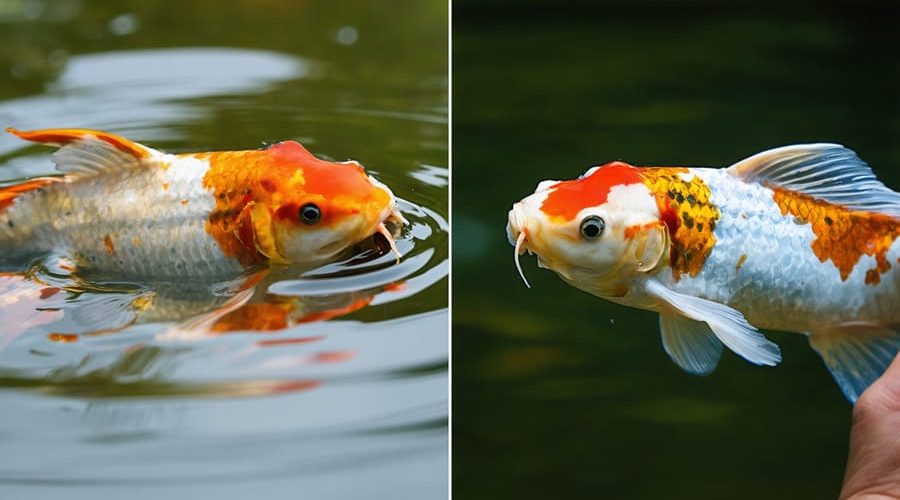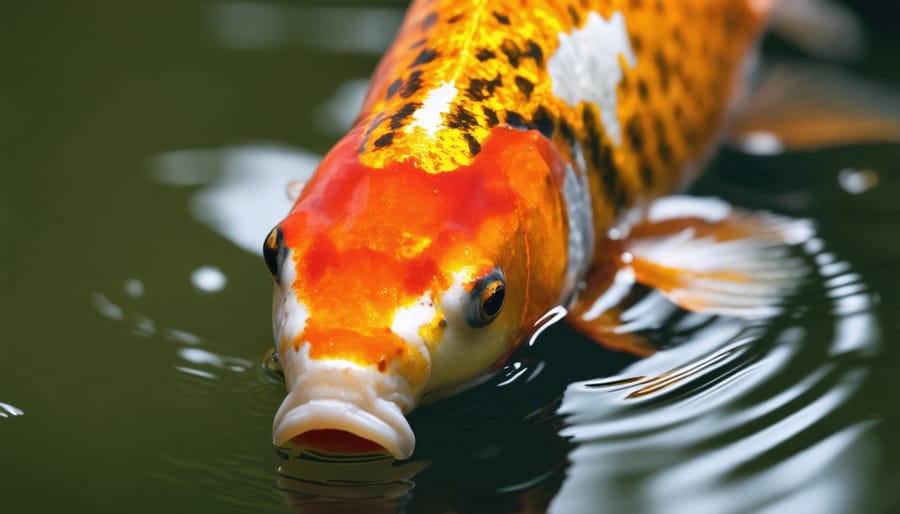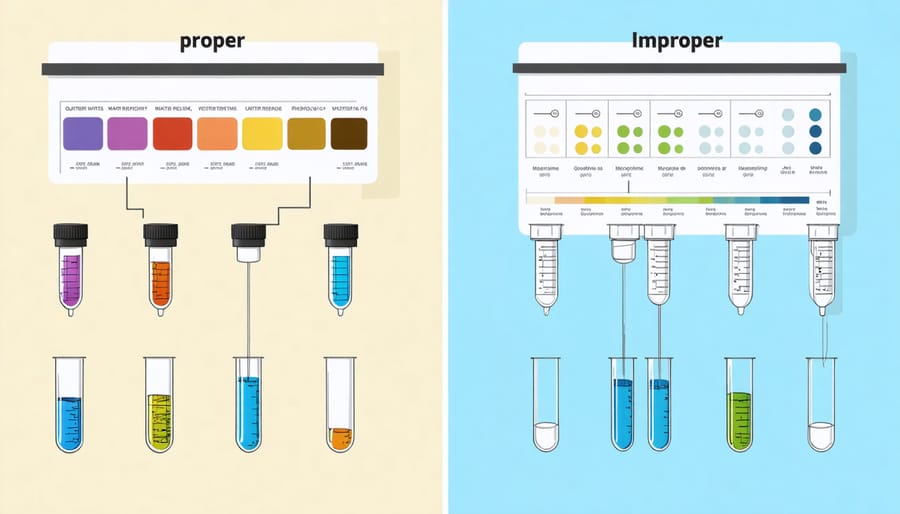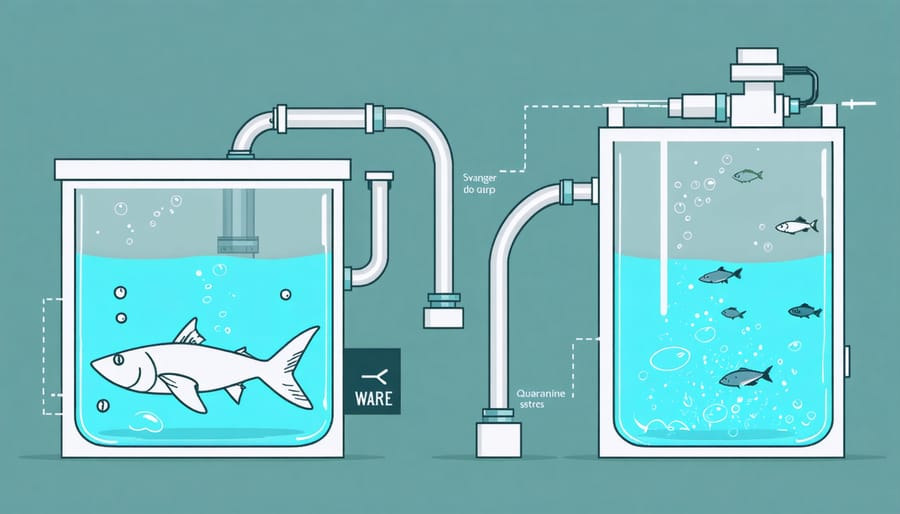
Save Your Koi: Spot and Solve Common Health Problems Before It’s Too Late
Protecting your koi’s health starts with daily observation and early intervention. These graceful Japanese carp, while hardy by nature, can face several health challenges that require immediate attention and proper care. From infectious diseases to water quality issues, understanding common koi health problems empowers pond owners to maintain thriving, vibrant fish populations. Regular monitoring of your koi’s behavior, appearance, and eating patterns serves as your first line of defense against potential health issues, while maintaining optimal water conditions creates a foundation for disease prevention. Whether you’re a seasoned koi keeper or new to the hobby, recognizing the signs of illness and implementing preventive measures can mean the difference between a minor issue and a serious health crisis.
Common Koi Health Problems and Their Warning Signs
Parasitic Infections
Parasites are among the most common health issues affecting koi fish, and catching them early is crucial for successful treatment. Common parasites include ich (white spot disease), anchor worms, and flukes. Watch for telltale signs like fish rubbing against surfaces (flashing), excessive mucus production, or visible spots on the skin. Ich appears as white, salt-like spots, while anchor worms look like tiny threads protruding from the fish’s body.
If you notice your koi losing appetite, becoming lethargic, or showing unusual swimming patterns, inspect them closely for parasites. A good practice is to observe your fish during feeding time when they’re most active. Using a magnifying glass can help spot smaller parasites, particularly on the gills and fin bases.
Regular water testing and maintaining proper pond conditions are your first line of defense against parasitic infections. Keep in mind that stressed fish are more susceptible to parasites, so maintaining optimal water quality and avoiding overcrowding are essential preventive measures. If you suspect a parasitic infection, consider quarantining affected fish to prevent spread and seek appropriate treatment options.

Bacterial and Fungal Diseases
Bacterial and fungal infections are common health challenges for koi fish, often appearing when water quality deteriorates or fish experience stress. Watch for signs like red or inflamed areas, cotton-like growths, and deteriorating fins. Ulcers, which appear as open sores on the fish’s body, are typically caused by bacterial infections and require prompt attention to prevent spreading.
Fin rot is another frequent issue, characterized by fraying or decaying fins. It usually starts at the edges and progresses toward the body if left untreated. White fuzzy patches on your koi might indicate a fungal infection, which often develops as a secondary problem after the fish has been injured or stressed.
To treat these conditions, first improve water quality through proper filtration and regular water changes. Many pet stores offer targeted medications for bacterial and fungal infections. For mild cases, adding aquarium salt can help prevent infection spread. However, severe cases may require specific antibiotics or antifungal treatments. Always quarantine infected fish when possible to protect your healthy koi and monitor their recovery closely.
Water Quality Related Issues
Poor water quality is often the root cause of many koi health issues. High ammonia and nitrite levels can cause stress, gill damage, and even death in your precious koi. Watch out for hidden dangers in ponds like excessive algae growth, which can deplete oxygen levels, especially during warm weather. Low oxygen levels make koi lethargic and vulnerable to diseases. Incorrect pH levels can damage their sensitive skin and affect their immune system. Regular water testing and maintenance are crucial to prevent these problems. If you notice your koi gasping at the surface or showing signs of distress, check your water parameters immediately. Installing proper filtration and maintaining regular water changes will help keep your koi healthy and thriving in their environment.
Prevention: Your First Line of Defense

Water Quality Management
Maintaining optimal water quality is crucial for preventing koi health problems. A proper filtration system and regular water testing are your first lines of defense against disease. Test your pond water at least weekly for ammonia, nitrites, nitrates, and pH levels using a reliable testing kit.
Keep ammonia and nitrite levels at zero, and maintain nitrates below 20ppm. The ideal pH range for koi is between 7.0 and 8.6, with 7.4 being optimal. Any sudden changes in these parameters can stress your fish and make them susceptible to illness.
Regular water changes are essential – aim to replace 10-15% of the pond water every two weeks. This helps maintain a healthy pond ecosystem balance and removes harmful build-up of waste products. During water changes, always use a dechlorinator to neutralize tap water chemicals.
Keep an eye on water temperature too – sudden fluctuations can weaken your koi’s immune system. Install a pond thermometer and maintain consistent temperatures, especially during seasonal changes. Adding air stones or waterfalls helps maintain proper oxygen levels, which is particularly important during warm summer months when oxygen levels naturally decrease.
Don’t forget to regularly clean your filter media and remove debris from the pond bottom. This prevents the accumulation of harmful compounds that could compromise your koi’s health.
Feeding and Nutrition
Proper feeding is crucial for maintaining healthy koi fish. Feed your koi 2-4 times daily during warm months, offering only what they can consume within 5 minutes. During winter, when temperatures drop below 50°F (10°C), reduce or stop feeding as their metabolism slows significantly.
Choose high-quality koi food that contains a balanced mix of proteins (35-40%), fats, vitamins, and minerals. Protein requirements are higher during growth periods and breeding seasons. While floating pellets are most common, you can supplement their diet with fresh vegetables like lettuce and watermelon for variety.
Watch for feeding behaviors that indicate health issues. Healthy koi should eat enthusiastically and maintain a steady appetite. If fish suddenly stop eating or become lethargic during feeding time, this could signal illness or poor water quality.
Be careful not to overfeed, as excess food leads to water pollution and can cause digestive problems. Remove uneaten food after feeding sessions to maintain water quality. Consider seasonal changes when adjusting portion sizes, as koi’s nutritional needs vary throughout the year.
Quarantine Procedures
Quarantining new koi fish is a crucial step that every pond owner should follow to protect their existing fish family. Set up a separate quarantine tank that’s at least 100 gallons, equipped with proper filtration and aeration. New fish should spend a minimum of 3-4 weeks in quarantine before joining the main pond.
During quarantine, maintain water temperature similar to your main pond and monitor your new fish closely for any signs of illness. Check them daily for unusual behavior, spots, or changes in appetite. This isolation period allows potential diseases to manifest before they can spread to your established koi population.
Test the quarantine tank’s water parameters daily and perform regular water changes to maintain optimal conditions. It’s also wise to treat preventively for common parasites during this time, even if fish appear healthy. Keep separate nets and equipment for your quarantine tank to prevent cross-contamination.
Remember, while quarantine might seem like an extra hassle, it’s much easier than dealing with a disease outbreak in your main pond. Consider it an investment in your koi’s long-term health and well-being.

Treatment Options and Solutions
Natural Remedies
When dealing with minor koi health issues, natural remedies can be an effective first line of defense before turning to medications. A salt bath using non-iodized aquarium salt can help treat mild bacterial infections and parasites – use 3-5 pounds per 100 gallons for 5-7 days. Apple cider vinegar dips (1 cup per 20 gallons of water for 5 minutes) can help restore the fish’s natural slime coat and fight fungal infections.
Garlic is nature’s antibiotic for koi. Adding crushed fresh garlic to their food strengthens their immune system and helps ward off parasites. For wounds or ulcers, applying honey directly to the affected area can speed healing thanks to its natural antibacterial properties.
Proper water quality management is perhaps the most important natural remedy of all. Regular water changes and maintaining optimal parameters often resolve minor health issues without additional intervention. Adding Indian almond leaves to your pond can naturally lower pH and release beneficial tannins that have antimicrobial properties.
Remember that while natural remedies are gentler on your fish, they’re not suitable for all health conditions. Monitor your koi closely when using any treatment, and consult a fish veterinarian if symptoms worsen or persist after trying natural solutions.
Medication and Chemical Treatments
When it comes to treating koi health problems with medications, it’s crucial to proceed with caution and follow proper dosing guidelines. Always start by accurately diagnosing the issue – treating with the wrong medication can do more harm than good.
For bacterial infections, antibiotics like tetracycline or kanamycin can be effective when used as directed. These should only be used when you’re certain of a bacterial problem, as overuse can lead to resistant strains. Parasitic infections often respond well to treatments containing praziquantel or formalin, but be sure to remove any carbon filtration before treatment.
Before adding any medication to your pond:
– Calculate the exact water volume
– Test water parameters (pH, ammonia, nitrites)
– Remove activated carbon from filters
– Follow dosing instructions precisely
– Monitor fish closely during treatment
Some medications can affect beneficial bacteria in your filtration system, so maintain extra vigilance with water quality during and after treatment. Consider treating affected fish in a separate quarantine tank when possible, as this allows for more controlled medication dosing and prevents unnecessary treatment of healthy fish.
Natural treatments like salt baths (using aquarium salt, not table salt) can be effective for mild issues and stress reduction. For fungal infections, methylene blue or similar antifungal treatments work well when caught early.
Remember that prevention through proper water quality management is always better than treatment. Keep a basic first aid kit with common medications on hand, but never use expired treatments or mix different medications without professional advice.
When to Call a Fish Veterinarian
While many koi health issues can be managed with proper care and maintenance, certain situations require immediate professional attention. If you notice your koi gasping at the surface, showing signs of severe injury, or experiencing sudden behavioral changes, it’s time to contact a fish veterinarian.
Other warning signs that warrant professional help include severe bloating, prolonged loss of appetite (more than 3-4 days), visible tumors or growths, and extensive parasitic infections that don’t respond to initial treatment. If multiple fish show similar symptoms or you experience sudden fish deaths, don’t wait – seek expert help immediately.
Red flags that require urgent veterinary care include:
– Severe physical injuries or deep wounds
– Extreme lethargy or inability to swim properly
– Visible hemorrhaging or large-scale loss
– Rapid onset of white or fuzzy growths
– Severe fin rot or ulcers
– Dramatic color changes combined with other symptoms
Remember, early intervention often leads to better outcomes. If you’re unsure about the severity of a problem, it’s better to err on the side of caution and consult a professional. Many fish veterinarians offer phone consultations to help determine if an in-person visit is necessary. Keep your local fish vet’s contact information handy, and don’t hesitate to reach out if you observe any concerning symptoms in your koi.
Maintaining the health of your koi fish doesn’t have to be an overwhelming task. As we’ve explored throughout this guide, being proactive and observant is key to ensuring your aquatic friends live long, healthy lives. Remember that prevention is always better than cure – regular water quality testing, proper feeding habits, and maintaining clean pond conditions will help you avoid many common health issues before they start.
Keep a close eye on your koi’s behavior and appearance. Those daily feeding sessions aren’t just about nourishment – they’re perfect opportunities to observe your fish and spot any potential problems early on. Watch for changes in swimming patterns, appetite, or coloration, as these can be the first signs that something isn’t quite right.
Establishing a regular maintenance routine is crucial. Make it a habit to check water parameters weekly, clean filters as needed, and perform partial water changes according to your pond’s requirements. Seasonal maintenance tasks, like fall cleanups and spring preparations, are equally important for maintaining a healthy environment for your koi.
Don’t forget the importance of quarantine procedures for new fish and having a basic first aid kit ready. Quick action can often make the difference between a minor issue and a serious health crisis. Building a good relationship with a knowledgeable koi veterinarian before problems arise is also invaluable.
While it may seem like a lot to manage, remember that each small step you take in maintaining your koi’s health contributes to their overall well-being. The reward for your diligence will be vibrant, active koi that bring joy and beauty to your pond for many years to come.
Most importantly, don’t hesitate to seek help when needed. The koi-keeping community is generally very supportive, and experienced keepers are often happy to share their knowledge. With consistent care, attention, and the right knowledge, you can create an environment where your koi will thrive and flourish.
